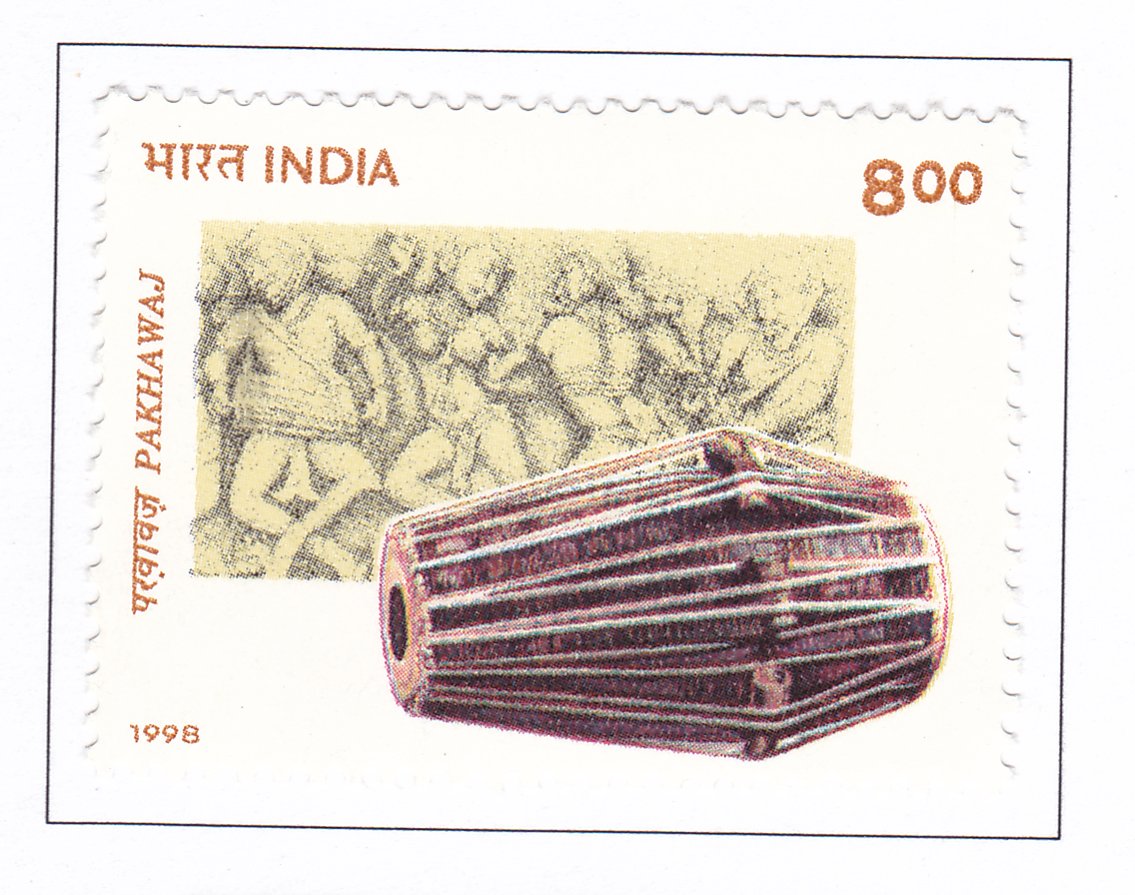Pakhawaj (wooden barrel drum)

Technical Data
| Stamp Set | Indian Musical Instruments |
|---|---|
| Date of Issue | December 29, 1998 |
| Denomination | Rs. 8 |
| Quantity | 700,000 |
| Perforation | comb 13½ x 13 |
| Printer | Security Printing Press, Nashik |
| Watermark | No Watermark |
| Colors | Multicolor |
| Catalog Codes |
Michel IN 1665 Stamp Number IN 1723 Yvert et Tellier IN 1430 Stanley Gibbons IN 1828 |
| Themes | Musical Instruments |
Table of Contents
Pakhawaj (Wooden Barrel Drum)
Overview:
The Pakhawaj is a traditional Indian percussion instrument, recognized for its deep, resonant sounds. It is a cylindrical, barrel-shaped drum used in various classical and folk music traditions in India. It is an important instrument in North Indian classical music and is known for its distinctive tonal qualities.
Characteristics:
- Structure:
- Material: The Pakhawaj is typically made from wood, with a barrel-shaped body that is hollowed out. The drum’s shell is covered with a layer of animal skin, usually from a goat or cow.
- Shape: The drum has a slightly tapering, cylindrical shape, wider at the center and narrower at the ends. This shape contributes to its unique sound quality.
- Heads: It has two heads (membranes) on either end, each tuned to different pitches. The heads are made from animal skin stretched over the drum’s body and secured with a series of ropes or tensioning mechanisms.
- Playing Technique:
- Position: The Pakhawaj is played while seated, with the drum placed horizontally on the player’s lap or on a stand.
- Sticking: The player uses the palms and fingers to strike the drumheads. Different parts of the hand are used to produce various sounds and rhythms. The left hand typically controls the lower-pitched end, while the right hand plays the higher-pitched end.
- Techniques: Advanced techniques include producing a variety of sounds, such as bass tones, resonant beats, and intricate rhythmic patterns. The drum is capable of creating complex rhythmic cycles known as “tala.”
- Historical Significance:
- Origins: The Pakhawaj has ancient roots, with references in classical Indian texts and historical documents. It is believed to have evolved from earlier types of drums used in religious and ritualistic contexts.
- Role in Music: Traditionally used in temple music, the Pakhawaj is integral to the performance of Dhrupad music, an ancient form of Hindustani classical music. It is also employed in other traditional Indian music genres and dance forms.
- Cultural Importance:
- Symbolism: The Pakhawaj is associated with spiritual and ceremonial music. Its deep, resonant tones are thought to evoke a sense of solemnity and devotion.
- Educational Value: Learning to play the Pakhawaj involves mastering complex rhythmic structures and developing a deep understanding of traditional music theory.
Commemorative Stamp Design:
- Visual Elements: The stamp depicting the Pakhawaj would feature the drum in its traditional form, highlighting the craftsmanship of the wooden shell and the detailed design of the drumheads.
- Background: The background may include artistic depictions of classical Indian music scenes or traditional performance settings, showcasing the Pakhawaj in its cultural context.
Educational Value:
- Understanding Tradition: The stamp helps to raise awareness about the Pakhawaj’s role in Indian music and its historical significance.
- Promoting Heritage: By commemorating the Pakhawaj, the stamp celebrates the instrument’s contribution to India’s musical heritage and promotes the appreciation of traditional percussion music.
The Pakhawaj stamp serves as a tribute to this classic percussion instrument, underscoring its importance in Indian classical music and its rich cultural legacy.
